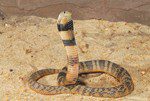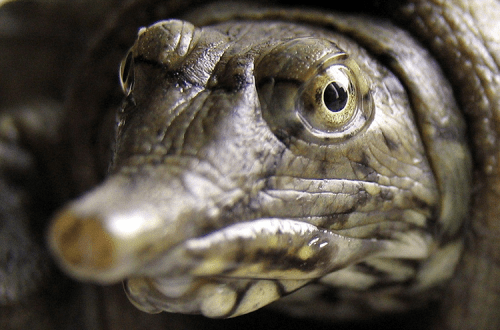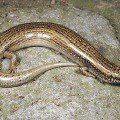
Caiman turtle
The Cayman tortoise is found from southeastern Canada to Colombia and Ecuador. Its shell in length can reach 35 cm, and it weighs an average of 14 kg. The caiman turtle looks simply menacing: a huge spiked head with bulging eyes, sharp powerful jaws that click like a bear trap. A sawtooth row of teeth on the tail, a mossy brown shell and long curved claws on the paws. The turtle is famous for its aggressiveness. The captured animal desperately defends itself: hissing menacingly, biting, strongly beating with a long tail covered with spikes and tearing everything that falls under them with sharp claws. It lives in a variety of fresh water bodies with a muddy bottom, in which it likes to dig. Her favorite dish is fish. The turtle hunts from an ambush, where it can spend hours, frozen, waiting for its prey.
Contents
Names in other languages
Chelydra serpentina – lat. species name, literal translation – biting turtle
Snapping turtle – English Cayman turtle
Inhabitation
The territories of Canada, the United States and South America include the habitat of the Cayman tortoise. Namely, it includes two of the three Maritime provinces of Canada – Nova Scotia and New Brunswick, as well as the largest Canadian province of Quebec. In western Canada, Cayman tortoises are found up to the border with British Columbia and further south. Even the North American Rocky Mountains did not become an obstacle to their resettlement, in which caiman turtles are able to exist at an altitude of up to 2000 meters above sea level. Over the mountains of the United States, these reptiles spread to the southeastern states of the United States – Texas and Florida, then covered Mexico and almost the entire territory of Central America to the northwest of the South American mainland, that is, countries such as Ecuador and Colombia.
Caiman turtle prefers to live in various water bodies, whether it be rivers, ponds or lakes. The main thing is that there should be a muddy bottom where the reptile can easily burrow. Sometimes the Cayman tortoise hides in the mud for a long time, for example, during hibernation, which lasts, especially in northern regions with a cold climate, from October to May. And although this animal is mostly found in fresh water, sometimes the Cayman turtle can also be found in brackish waters.
Description
 Cayman turtles are quite large, their shell can grow up to 35 cm, and the total weight of the animal can reach 30 kg. Zoologists do not recommend approaching this large and dangerous predator, grabbing everything that is within the reach of its powerful paws. The behavior of the caiman tortoise in water differs from that on land. There she feels safe, and yet she continues to be on her guard. Even getting out on land to bask in the warm air, the caiman turtle burrows into the muddy bottom of the shallows so that only the eyes and nostrils of the animal stick out of it. And the cold season almost does not cause any inconvenience to the reptile. In winter, the caiman turtle can be seen swimming under the ice. However, winter torpor is still characteristic of the animal. At this time, the caiman turtle may burrow into the mud, hide in the vegetation at the bottom of the reservoir, or occupy the houses of aquatic mammals such as the muskrat.
Cayman turtles are quite large, their shell can grow up to 35 cm, and the total weight of the animal can reach 30 kg. Zoologists do not recommend approaching this large and dangerous predator, grabbing everything that is within the reach of its powerful paws. The behavior of the caiman tortoise in water differs from that on land. There she feels safe, and yet she continues to be on her guard. Even getting out on land to bask in the warm air, the caiman turtle burrows into the muddy bottom of the shallows so that only the eyes and nostrils of the animal stick out of it. And the cold season almost does not cause any inconvenience to the reptile. In winter, the caiman turtle can be seen swimming under the ice. However, winter torpor is still characteristic of the animal. At this time, the caiman turtle may burrow into the mud, hide in the vegetation at the bottom of the reservoir, or occupy the houses of aquatic mammals such as the muskrat.
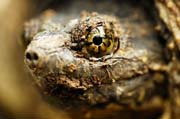
The color of the karpaska – the upper part of the shell Cayman turtle – predominantly brown with a darker pattern on each plate. It has three rows of keel-like protrusions, turning into large notches towards the tail. The ventral plastron of the animal is small, yellowish in color and cruciform in shape. The body of the Cayman tortoise is large, and the carpax does not cover it entirely, the head and long tail usually remain outside. Perhaps that is why the Cayman tortoise is so actively and aggressively defending itself from danger. The head spikes, which give it a particularly menacing appearance, are in fact nothing more than horny scales that serve to protect exposed areas of the body. And the same spiny processes are on the neck of the reptile. The color of her paws from top to bottom changes from a dark shade to yellowish, and their skin is dotted with growths that look like warts.
The Cayman tortoise, like other members of the detachment, has no teeth. But there is a short and powerful beak with sharp edges, easily grinding the bones of live prey. By the way, in hunting, the reptile shows not only amazing patience, but also cunning. The caiman turtle lures fish with a mobile growth on its tongue, resembling a trembling worm in the water. These reptiles tend to show aggression towards each other if they feel competition or divide the territory. As a result of the fight, one individual kills the other by biting off its head.
It seems that in the body of the Cayman tortoise, everything is adapted to intimidate the enemy. It not only actively defends itself, but also secretes a musky liquid with an extremely unpleasant odor from the inguinal glands.
Food
The main food of the Cayman tortoise is mainly fish, various small water animals and even waterfowl. It can be both living and dead creatures, including carrion. Among plant foods, the caiman tortoise prefers everything that it can find in the water. She finds carrion by smell, and unexpectedly attacks live prey from an ambush. Yes, and she herself is an object of hunting, since the meat of young caiman turtles is the basis of the world-famous turtle soup. From the same point of view, reptile eggs are also valued.
However, zoologists have determined that, despite the predatory instincts, the main food of Cayman tortoises is still vegetable. So it is also possible to feed an animal in captivity. He should be given the same fish, both live and thawed, as well as bloodworms, earthworms, crayfish and snails. Some breeders practice feeding Cayman tortoises raw meat. Plants that serve as food for a reptile should be placed or planted in its aquarium (if it is not poisonous seaweed) as often as possible. Cayman turtles are voracious.
Reproduction
The mating season occurs in Cayman turtles in the spring. At this time, males are able to arrange terrible fights. Can get from the male and actively resisting the female. However, scientists note that for all their aggression, caiman turtles are also prone to graceful courtship, reminiscent of ritual dances. Reptiles mate under water, and almost immediately after fertilization, the female arranges a nest. Mating games occur in Cayman tortoises throughout the active season, from early spring to late autumn. They reach sexual maturity when they reach 18-20 years old, which is not so much in comparison with the total life span of turtles (more than 100 years). You can also track the time of growing up by the length of the plastron, which reaches about 14 cm by this period.
After fertilization, the female caiman tortoise can start nesting immediately, or can keep the viable sperm of the male in her oviduct for up to six months or more. Females that are ready to lay eggs like to build their nests in warm sand far enough from the water. To arrange nests, caiman turtles use everything that is “at hand” – sawdust, plant debris and other available materials. The female chooses a place for laying for a long time and carefully, and then uses it constantly. True, caiman turtles are often attracted to roadsides, and the masonry is destroyed under the wheels of cars.
At the chosen place, the caiman turtle with its hind legs digs a hole in the shape of a cauldron, the size of which depends on the size of the female herself. At the bottom of this hole, a narrow mink is arranged – an egg chamber, where the caiman turtle very carefully lays about 20-30 eggs, similar to tennis balls. After 2-4 months, small turtles emerge from them, the sex of which, like that of other members of the detachment, depends on the external temperature. The offspring of caiman turtles hatch in the same season from August to October. But in northern climates, masonry can lie until next season.
Small caiman turtles are aggressive at birth, actively moving and biting.
Content
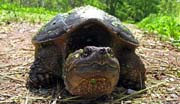 Cayman turtles are not friendly animals. Their intransigence can never be broken, so it is unlikely that such a reptile will make a suitable pet. However, lovers of the exotic often have caiman turtles at home, however, attempts to tame this freedom-loving animal can be traumatic. With its hard jaws, the caiman turtle can, if not gnaw through, then seriously damage a human hand. But if you still decide to keep a reptile predator at home, then he needs a large (and even very large, since caiman turtles grow quickly with a regular and varied diet) terrarium. In the best case, a specially equipped garden pond, well-fenced, may also come up, otherwise the curious and prone to changing places, the caiman turtle will set off to travel, frightening the passers-by and animals it meets. Yes, and harsh Russian winters can lead to the death of a reptile.
Cayman turtles are not friendly animals. Their intransigence can never be broken, so it is unlikely that such a reptile will make a suitable pet. However, lovers of the exotic often have caiman turtles at home, however, attempts to tame this freedom-loving animal can be traumatic. With its hard jaws, the caiman turtle can, if not gnaw through, then seriously damage a human hand. But if you still decide to keep a reptile predator at home, then he needs a large (and even very large, since caiman turtles grow quickly with a regular and varied diet) terrarium. In the best case, a specially equipped garden pond, well-fenced, may also come up, otherwise the curious and prone to changing places, the caiman turtle will set off to travel, frightening the passers-by and animals it meets. Yes, and harsh Russian winters can lead to the death of a reptile.
In a home terrarium, for some time it will be possible to keep only a young and not yet very large caiman turtle. And, of course, in her dwelling there must be water, which will have to be changed quite often. The most favorable conditions for the life of reptiles in captivity are the air temperature of about 25 degrees, water – 20. It is easy to provide food for the caiman turtle. Small animals are suitable for this – frogs, mice, various types of fish. As a plant food, she can be given vegetables, such as cabbage or lettuce. Some terrarium keepers even let their pet walk around the room. True, it is recommended to remove from it all other animals in the house.
The caiman tortoise is not afraid of a man at all, rather, she ignores him. You can try to teach the animal to take food from your hands, but it will never put up with servitude, and you should not expect any gratitude from the turtle. Sometimes in human captivity, the caiman tortoise refuses to eat. However, she is able to live in a home terrarium for up to 60 years.
Additionally
In many parts of the United States, its meat is eaten by local residents.
The caiman turtle has such hard jaws that it can gnaw through a human hand.
Classification
Kingdom: Animals
Type: Chord
Subtype: Vertebrates
Class: Reptiles
Order: Turtles
Suborder: Hidden-necked turtles
Family: Cayman turtles
Genus: Chelydra (cayman, biting)
Species: Cayman turtle
Sources of
http://ru.wikipedia.org
http://www.cherepahi.ru
http://www.floranimal.ru/
http://dic.academic.ru/
http://myreptile.ru
http://www.zooclub.ru



